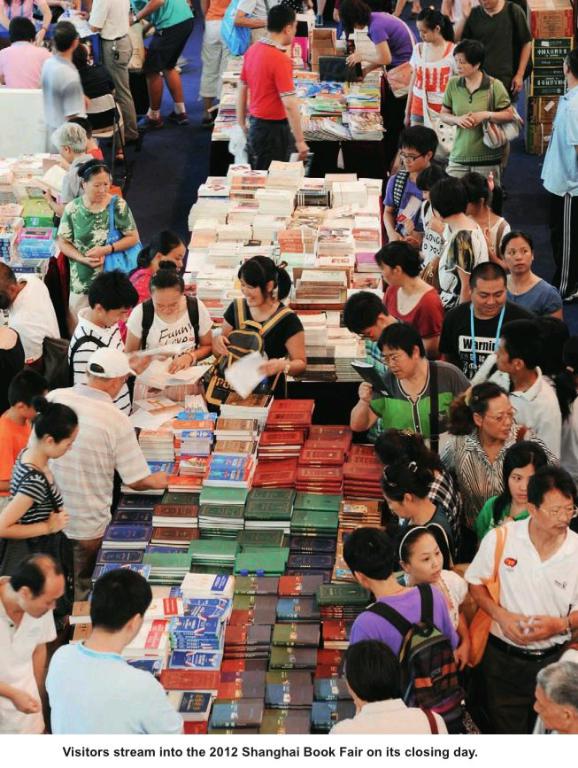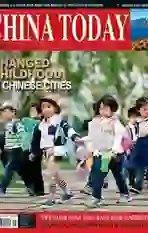Reading,Back in Vogue
2014-09-27BystaffreporterDA
By+staff+reporter+DANG+XIAOFEI
More Time for Reading
A study by the Chinese Academy of Press and Publication shows that the countrys reading rate began to rise in 2005, after a steady downturn from 1999. Results of the 10th national survey of Chinese peoples reading activities, released in 2013, also backs up this conclusion: 54.9 percent of Chinese aged 18 to 70 curled up with a book in 2012, one percent higher than in the previous year.
Hao Zhensheng, president of the Chinese Academy of Press and Publication, credits this uptick in the reading curve to a confluence of macro and micro factors. With higher incomes, citizens tend toward more cultural pursuits. This would explain why the academy has found that books sell better in more economically developed regions. The government has also played a positive role in rekindling a love for books. More than 400 Chinese cities have staged various reading promotion campaigns, such as reading months or reading weeks. As well, the spate of public libraries built across the country over recent years has given local residents better access to books. In addition to the sleek, multistoried urban libraries, there are also 600,000 smaller ones in rural communities with stocks numbering close to one billion books.
The Return of Belles-lettres
The reading tastes of Chinese people are evolving. Formerly, the bestsellers would be mostly instructional and advice books that people turn to for solutions to the problems they encounter in life. They are now the more artistic and imaginative works of literature. The 2013 figures for Dangdang. com, the worlds largest Chinese online bookstore, show that sales of new books on literature and art including fiction and youth dramas rose by one third over the previous year.
As Dangdang dominates almost half the online book sales in China, its figures are a reliable indicator of the general reading habits of Chinese people. In 2009, its top sellers were The Wisdom to Protect Yourself from Illness and A Good Kid Outplays a Good Teacher. The titles tell it all: both provide supposed solutions to meet practical needs. On Dangdangs 2013 bestseller list, the four highest slots went to: The Shadow Thief (Le Voleur dOmbres) by Marc Levy of France; See, a autobiography by former CCTV host Chai Jing; The Wind Shearing Clouds, a collection of essays by post-1980s star writer Guo Jingming; and Thank You for Leaving Me, essays on love by Hong Kongs Amy Cheung Siu Han. All fall into the genre of soulsearching or thought-provoking books. Zhu Xiaofan, an editor of a Beijing-based publishing house, indicated that the 2013 bestseller by her publishing house is So Young, a youth novel, also belonging to this genre. Ms Zhu, in her early 30s, has a penchant herself for youth stories and fiction, particularly detective stories.
See – a reflection on the decade Chai Jing spent hosting CCTV investigative programs – sold out in many stores during its debut at the end of 2012, and has remained popular to date. It relates, from an insiders perspective and in an intimate tone, some of the most significant events in China over that period, including the SARS outbreak, the Wenchuan earthquake, and the Beijing Olympic Games. Such subjects can easily grab reader attention. Moreover, the broad fan base of the witty attractive young host also plays a role in its strong sales. Another highlight of Chinas 2013 book market is that many of the bestsellers were titles released that year, breaking away from older trends.
E-books on the Rise
It is now an omnipresent sight on public transport – people hunched over their mobile phones or other electronic gadgets, browsing news or perusing stories.
Zhu Xiaofan takes out an e-reader to catch a few lines while waiting for the bus, so as she explains, to “make the best of my time.” She also has a habit of reading an e-book in bed before falling asleep. “It offers some relaxation,” she says.
The 10th national survey of reading activities found that Chinese people read on average 2.35 e-books in 2012 – a 65.5 percent jump over 2011. Digital reading also found its way to 40.3 percent of the Chinese population, rising 1.7 percent from 2011.
Chi Yukai, head of the Human Resources Management and Psychological Evaluation Department of South China Normal University, observes, with more avenues to obtain information, fewer people today opt to study in depth through printed books. In many homes, computers are replacing bookshelves, and this explains the widespread closure of mortar-and-brick bookstores throughout much of the world.
Many have expressed concern that printed books could die out one day. Zhang Yiwu, a famed commentator and Peking University professor, is one of those who disagree: “However rapidly e-reading may develop, printed books are here to stay, just as calligraphy has survived unscathed through the age of keyboard input.”
According to the 10th national survey of reading activities, over 90 percent of the Chinese people who ever read on screens are 49 years old or below. Overall, the printed book is the mainstay reading material for more than 70 percent of the Chinese population.
Zhang Ming, who works for a state-owned company, prefers printed books for their texture, which he claims possesses a calming magic. “If you are lucky enough to find decades-old publications, the aura of time and history is even stronger,” he says. Also, he often becomes captivated by a book during a casual skim through a bookstand at an airport, where only print publications are available.
Children, the Future Market
Last year Dangdang.com added 19,800 new titles to its childrens booklist, marking a 14 percent growth. Dangdang CEO Li Guoqing predicts that sales in this category could soon double, under the strong momentum of digital books.
“Despite slowing growth for book sales in general online and off, last year childrens books maintained a robust growth of 6.65 percent, outperforming all other categories,” says Jiang Yanping, general manager of OpenBook, a sales monitoring service provider for Chinese books.
“The childrens book market has huge room for further growth, which conventional stores like Xinhua can tap into,” Lü Cunzhou, deputy general manager of the Zhejiang Xinhua Bookstore Group predicted. “Childrens publications are top profit makers for conventional bookstores. The overall daily gross profit produced for every square meter of our retail space is RMB 7.9, but that from childrens books stands at RMB 20.”
The strong surge in the childrens publication market is attributed to accelerated efforts by government, private organizations and individual citizens to promote reading among the younger generation.
Wang Yuan, head of childrens publications at the Anhui Xinhua Bookstore Group, believes Chinese people born in the 1970s and 1980s are better educated than previous generations, and therefore pay greater attention to nurturing their children, which fuels development of childrens book market.“Every weekend many parents bring their children to bookstores – the real ones. Those with a physical presence have bigger stocks than their virtual counterparts, and whats more, offer an enticing atmosphere for reading. When kids see stuff in print, they are more likely to open it and read it.”
